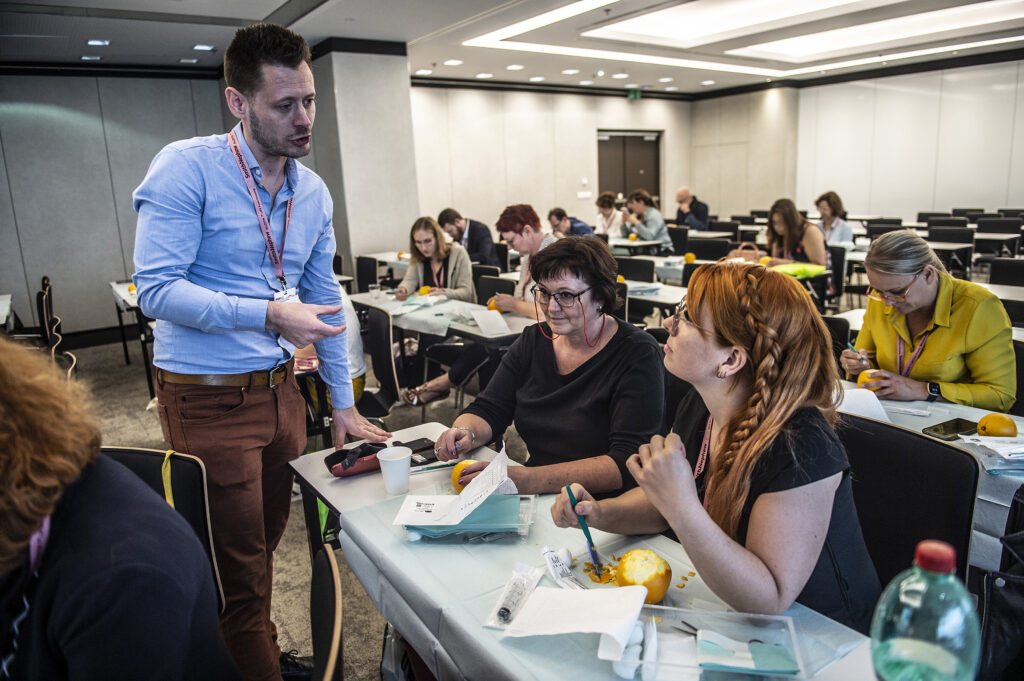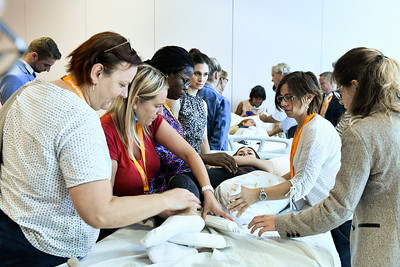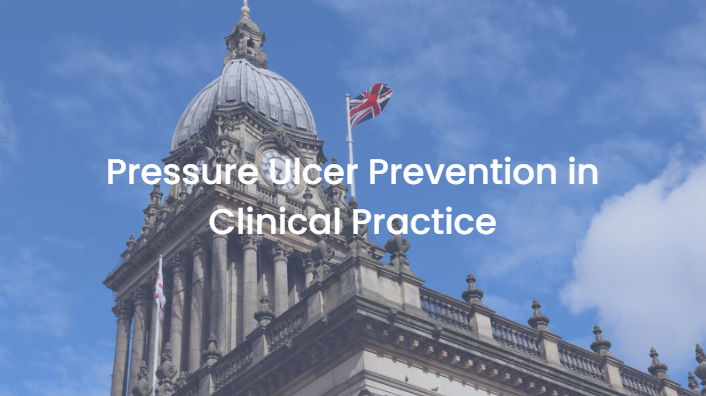


EPUAP 2023 Workshops
Due to the limited capacity of workshops, we recommend saving a place via pre-registration.
The role of risk assessment in pressure ulcer prevention (Susanne Coleman, Great Britain) 15.09.2022 10:45 – 12:00
GIBBON workshop (Kevin Moerman, Ireland) 15.09. 2022 13:15 – 15:30
Repositioning (Menno Van Etten, Norway) 15.09.2022 13:15 – 14:30
Debridement (Lucie Charbonneau, Switzerland and Steven Smet, Belgium) 15.09.2022 16:40 – 17:40
Wound assessment (Helen Strapp, Ireland) 16.09.2022 09:00 – 10:15
Skin care considerations for the patient in the prone position (Dimitri Beeckman and Anika Fourie, Belgium) 16.09.2022 09:00 – 10:15
Pain in pressure ulcers (Jane Nixon, Great Britain) 16.09.2022 11:00 – 12:00
Pressure ulcer prevention in younger population (Guido Ciprandi, Italy and Ann Marie Nie, USA) 16.09.2022 11:00 – 12:15
Lunch Workshop: Natural Wound Care by Guido Ciprandi & Renato Colognato (Italy)
Nowadays antibiotic resistance is a topic of social concerns and a document released by the Italian Ministry of Health (January 2022) estimate that more than 35.000 dead’s per year for antibiotic resistance pathogens, with an estimate cost of 2,3 billion of Euro with a higher risk for countries with a reduced level of social health services, has been registered during the last years.
Moreover in 2017 the European mean of Pseudomonas aeruginosa and E. coli resistance strains has been estimated around 15,7% and 7,8% respectively. Saying that there is an urgent need to solve this medical and social topic and to scientific validate researches aiming to find valid clinical alternatives. During the last decades, a lot of interest by the scientific community has been given to phytochemical and bioactive natural compounds that were able to show interesting clinical data in favor of their usage has alternatives to antibiotics in different medical fields.
This is the main street that we need to take and drive if we want to solve the problem. Moreover society is getting more and more multicultural. In this melting pot of traditions, new trends and false beliefs, there needs to “look back to what tradition was able to teach us in terms of benefits and curing capacity of botanicals and phytochemicals basing on a personalized and a precise medicine approach”.
One third (2,3 billion people) of the world’s population has no access to medical treatments, neither to advanced dressings. On the other hand wounds affect more “democratically” human beings, and therefore the knowledge of the widest spectrum of possible treatments is mandatory. Some of these active principles traditionally used have already been validated by the scientific community and mutuated to lead new therapies.
With the above-mentioned rationale the Garden Class shall focus the attention on the scientific state of the art of natural products – plants, herbs, fungi, and animals (larvae) – in the wound clinical management. Traditional Chinese,Tibetan, African, Latin americans, native americans and European remedies for treating wounds will be presented.
Companies: Erbagil Technology, Mesitran, Integra Life Sciences
Workshop: Debridement by Lucie Charbonneau (Switzerland) and Steven Smet (Belgium)
Throughout this workshop, the participants will be introduced to various types of debridement and will explore a comprehensive wound assessment methodology to evaluate whether wound debridement is required or not. In the 2nd part the participants can practice their sharp debridement skills to experience the importance of professional accountability and to recognize the possible limitations when performing a sharp debridement in clinical practice.
Workshop GIBBON: the open source toolbox for computational biomechanics by Kevin Moerman (Ireland)
Join this workshop to learn about GIBBON: a FREE and open-source MATLAB toolbox for computational biomechanics. Applications, in the context of pressure ulcer research include tissue load evaluation, as well as the computational design and optimisation of biomechanical interfaces, such as mattresses and prosthetic sockets. GIBBON includes tools for image-based modelling and segmentation, geometry processing, meshing, and, by interfacing with FEBio, advanced finite element analysis. The first half of this workshop provides an overview of GIBBON’s core functionality in the context of pressure ulcer research. In the second half attendees are guided to explore functionality themselves, and have the opportunity to apply GIBBON to their own data and applications.
Learning objectives
Through this workshop you will be introduced to:
• Finding GIBBON documentation and running demos
• Obtaining model geometry from 3D image data
• Basic geometry processing, such as cutting, extruding, smoothing, and remeshing
• Creating volumetric meshes (e.g. tetrahedral and hexahedral meshes)
• Specifying finite element model boundary conditions in GIBBON
• Running GIBBON coded FEBio models from MATLAB
Workshop: Materials for Pressure Ulcer Prevention in Children by Guido Ciprandi (Italy) & Menno van Etten (Norway)
Focus on High-Technological components, 7 points performance, slow-memory, resilience, viscoelasticity, density.
When the knowledge of the details enters microscopically inside the components we use and helps us to improve the lives of our patients also through a more articulated and correct parental counseling.
Lessons translated from medical physics to the medical clinic and the Skin Care Team.
Workshop: Repositioning & managing contractures by Menno van Etten (Norway)
Traditional EPUAP workshop on Repositioning and managing contractures.
When taking in mind the EPUAP definition of pressure ulcers: “a localized injury to the skin and/or underlaying tissue, usually over a bony prominence”, the goal for positioning and repositioning an individual should be to reduce the time spent laying directly on bony prominences.
In this workshop participant will practice on the 30 degrees side lying position and get hands on tips how to handle the challenges this position has. For example, how to position the individual stable, comfortable and secure, so they will be able to lay over prolonged periods of time.
The backdrop of being immobile over prolonged periods of time is that patients can develop contractures. At this workshop we will discuss preventive measures but also how to reduce the consequences of contractures.
Workshop: Clinical trials research by Jane Nixon & Isabelle Smith (United Kingdom)
In the pursuit of answering clinical questions about treatment effectiveness, the randomised controlled trial (RCT) is the ‘gold standard’ research methodology. RCTs are complex in design and implementation in high risk and PU populations, but significant progress has been made in recent years, with the delivery of a small number of large trials delivered by European research groups. This workshop aims to build upon this experience and expertise and promote knowledge sharing from other clinical specialties, to enhance appraising and research skills.
Content
Using examples from high quality clinical trials in the wound care and general medical fields, the interactive workshop aims to introduce:
- important principles in trial design and trial conduct issues including randomisation, and defining the analysis population
- randomisation design
- a range of trial designs including phase 2, feasibility and phase 3 trials
- concepts of bias and generalisability
- international standards in the reporting of clinical trials – the CONSORT statement
- practical solutions to the methodological challenges in conducting high quality trials.
Participation
The workshop will include a practical randomisation component, enhancing understanding of allocation bias, stratification and randomisation design.
Clinical relevance
This workshop is will be useful to those appraising evidence for clinical practice or those undertaking research.
Workshop: Pressure ulcer prevention in clinical practice by Britt Hansen (Denmark), Steven Smet (Belgium) and Camilla Leerskov Sorensen (Denmark)
We will inspire you with a number of practical examples, after
which we will break you into small groups to work on a specific case. At the
end, we meet again with the whole group to discuss the results.
Workshop: Purpose T by Susanne Coleman (United Kingdom)
The workshop will incorporate a short power point presentation to summarise the evidence base of risk assessment; the development of an evidence based Risk Assessment Framework – PURPOSE T developed as part of the NIHR PURPOSE Programme of research. Using realistic community and acute vignette case studies, delegates will then have the opportunity to practice using PURPOSE T. Reflection and feedback will be requested to support implementation locally and internationally.
Learning Objectives
1. Update understanding of key pressure ulcer risk factors and risk assessment practice.
2. Be confident using PURPOSE T with vignettes.
3. Assess whether their current risk assessment practice is in line with the evidence base.
4. Consider issues affecting implementation of PURPOSE T in clinical practice.
This presentation presents independent research funded by the National Institute for Health Research (NIHR) under its Programme Grants for Applied Research Programme (RP-PG-0407-10056). The views expressed in this presentation are those of the author(s) and not necessarily those of the NHS, the NIHR or the Department of Health.
Workshop: Dressing properties and selection by Lucie Charbonneau (Switzerland) & Camilla Leerskov Soerensen (Denmark)
Through brief theoretical inputs, clinical cases and shared discussion with the participants, we will look into how dressings are currently evaluated in laboratory testing for predicting their clinical performance.
We will briefly recall the fundamentals of wound care, wound assessment, wound healing stages and factors influencing wound healing. We will explore and discuss the different types of wound dressings available, the indications, contraindications, and appropriate uses of various dressings. The discussions will include the wound characteristics, exudate levels and patient preferences such as both compliance and skin objectives.








